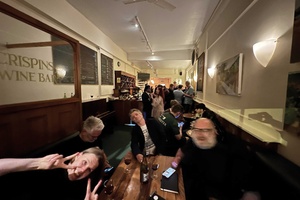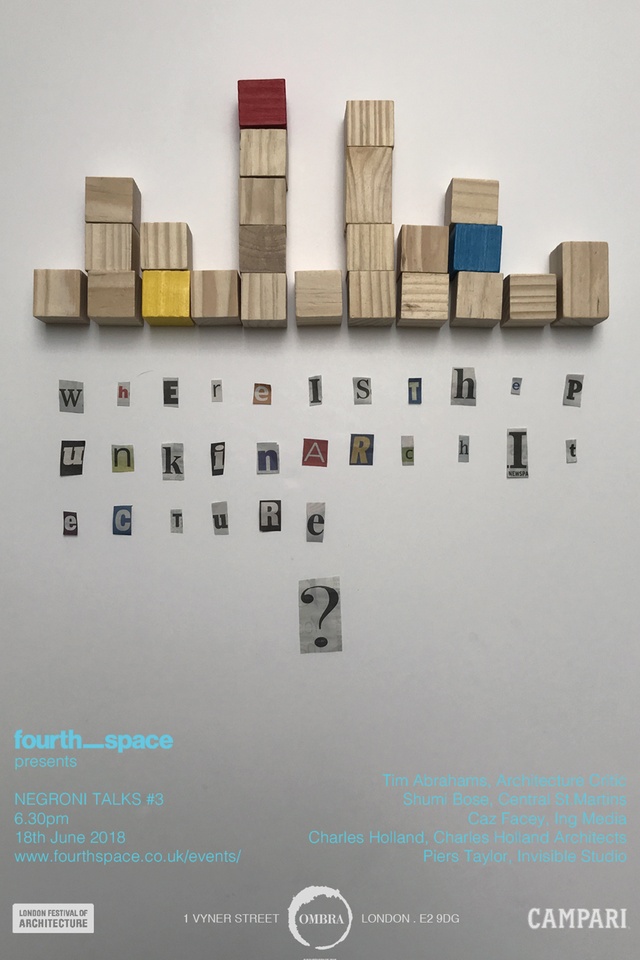Talking Architecture: From Bla-bla-blarchitecture to the Negroni Talks
June 2024
Aotearoa – United Kingdom
The history of architecture is a complex history of intertwined languages. It is the language of building. That is: form, structure, materials and technology. It is the language of drawing, including the sketch, isometric, axonometric and parametric. It is the language of writing, covering theory, critique, reportage and narrative.
Yet, the history of architecture offers scant evidence as to the language of talking. To design is to talk, and to talk is to design. The sound of the studio is the chit-chit-chatter of debate and discussion, the verbalised brainstorming of ideation and think-tanking, the heated exchange of critique and the propositional rap of salesmanship. At its zenith, the conference transforms architecture into ‘archi-lecture’.

Talking about architecture is the fastest way to accelerate the design process. Furthermore, only in speech can architecture communicate as conversation, in dialogue. Because of its ease and ephemerality, speech hasn’t, however, been afforded the same status as have other forms of architectural representation: the drawing, the model, the building and the text.
If buildings could talk, what would they say? Film director Wim Wenders thinks “some of them would sound like Shakespeare. Others would speak like the Financial Times, yet others would praise God or Allah.” Ledoux’s phrase ‘architecture parlante’ speaks of an architecture that explains its function or identity. Yet, the unhappy landing of Form Follows Function is the duck as building: architecture that’s gone all emoji, <3.
For cultures with oral, not written, traditions, building knowledge has been transferred through talking and making. For indigenous communities, this manifests as wānanga, talanoa and hui. Kōrero became pūrākau and waiata perpetually recited across generations.
My daily oscillation between home and work is a pedestrian commute, which provides a headphoned opportunity to listen to architects talking. Bla-bla-blarchitecture was our London practice blog, voicing speech as the ultimate design tool. I have sat in on a rollicking chat with the 76 Small Rooms team, which has since hosted 53 conversations about architecture and design in Aotearoa and beyond. Most recently, Bill McKay talked about Urban Aotearoa. Jade Kake presented the formidable 24-episode Indigenous Urbanism, place-based storytelling about the Indigenous spaces we inhabit and those who shape them. In 2021, Jade lectured to the Harvard Indigenous Design Collective, where Harvard GSD has podcasted, since 2018, its 13-series Talking Practice. Architects talk about the ways in which design imagination is articulated through practice. As a practitioner now sited/cited in academia, I maintain that innovation in architecture ultimately derives from practice. And the practice design tool of choice is speech.
Gathering many voices in the room to talk leads me to the live audience podcast that I sat in on whilst recently back in London: the 66-episode Negroni Talks.

Campari supports this East London podcast. Set up to be lively and provocative debates, the podcast venues (Venetian restaurant Ombra, bakery Forno) are owned by the Talks’ creators, architects fourth-space. The venues are significant as the talks are designed to emulate the opinionated and convivial free-flowing debates found in fin-de-siècle European café society. Each event is fuelled by food and drink (particularly Negroni); there’s no stage, no standing on ceremony and the audience is asked to participate as much as are the (four plus) invited speakers. The recordings are later presented as they happened live and, like the talks themselves, with no frills and little-to-no editing, to bring a sense of the evening as it happened: live and direct.
Fourth-space’s architectural legacy lies not in its building output but, ultimately, in its Negroni Talks, which have attracted architectural luminaires, including Sir Peter Cook (Archigram), Patrik Schumacher (Zaha Hadid), Paul Finch (WAF), Eva Franch i Gilabert (AA), Jeremy Till (Architecture Depends), Nigel Coates, Amin Taha (Groupwork)… taking on all manner of provocations, such as What Will Brexit Actually Look Like?; Archi-speak: Time to Kill the Jargon?; Thick as a Brick: Dis Honesty and Architecture…; I’m So Bored with the RIBA: Irrelevance Institutionalised?; and Mind the Gap: the Chasm Between Practice and Education.
Here are two soundbites from Where’s the Punk in Architecture? The Chair immediately lays down post-punk band Wire’s rules of Negative Self Definition, which really should apply to every talk from any architect: “1. No Solos; 2. No Decoration; 3. When The Words Run Out, It Stops!; 4. No Chorusing Out; 5. No Rocking Out; 6. Keep To The Point; 7. No Americanisms”. Later on, Charles Holland, author of How to Enjoy Architecture, tells the story of Ben Kelly, who, whilst designing the famous Haçienda nightclub (which fostered the acid house and rave scenes), tried to twin his professional career with the hedonistic ‘24-hour party people’ pursuits of his client, the band New Order.
A Negroni has a neat architectural cubic form: 1/3 Campari, 1/3 Vermouth, 1/3 Gin. Similarly, the Negroni Talks triangulate place, people and purpose, leading to an entertaining cocktail of event-based architecture and learned fun. We hope to welcome the Negroni Talks crew to Aotearoa New Zealand in 2025.










